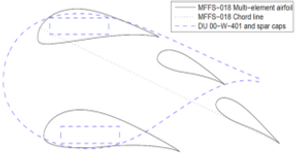
THE SKYPULL TECHNOLOGY
01
DESIGN
The Skypull drone has a double wing design to maximize lift with reduced wingspan. Additionally, each wing is made of a multi-element airfoil that maximizes lift and minimizes drag for best flying efficiency, similar to the wing of a commercial airplane during take-off and landing. The original patented design “box wing” guarantees increased strength, reduced weight and high resistance to fatigue. Hence, the Skypull drone represents a revolutionary design for optimized flying efficiency and maximum lift, for high capacity (MW) airborne wind energy production.

The wing section profile

The drone design

wing profile CFD analysis
02
CONTROL SYSTEM
Continuously updated "State of the Art" control technology grants intrinsic system safety and reliability to our unmanned aerial vehicle, with no need for special structures or complex operations for autonomous take-off and landing. Immediate and effective flight response ensures efficient operation in vaying winds with high reliability and safety levels, even in case the tether breaks.

The Skypull concept
03
PERFORMANCES
Thanks to the reduction of material and a higher capacity factor Skypull airborne wind energy system will be able to achieve lower LCOE than wind turbines, thus being competitive with fossil fuel based power generation, even in absence of public incentives.
Less materials and higher energy production also give Skypull's solution a very high Energy Return on Energy Invested (EROEI) - the parameter representing the real advantage of technology for an energy transition. A value comparable to the EROEI of oil industry one century ago, when large deposits were easily accessible.


Materials required for
the realization, O&M
and decommissioning
of the system under a
LCA perspective
Net energy produced
in a year
LCoE projections, compared to a wind turbine
Levelized Cost of Energy:
all inclusive cost per unit
of energy produced by
the system

Energy Invested for
the realization, O&M and decommissioning of the system under
a LCA perspective
Net energy produced
in a year
Energy Return on Energy Invested: net energy provided by the system under a LCA perspective
ERoEI projections, compared to a wind
turbine
04
SCALABILITY
Due to the intrinsic strength and low weight of the drone, the Skypull technology ensures scalability up to MW generator class, with a planned 17m wingspan drone for 1 MW generating capacity.
Variable scalability of production, with a continuous process of Skypull's drone structural parts, will allow higher production capacity and lower cost than with traditional production processes of aeronautic composite parts.

The development plan
05
OWNERSHIP
The Skypull intellectual property has been protected in 2015 by granted Patent No. ITUD2015A000038, successively expanded to PCT/EP2016/000479 and furtherly extended worldwide.
The overall IP strategy is actively and continuously managed.
A Freedom To Operate assessment has also been realized, in order to ensure the deployability of the system.
